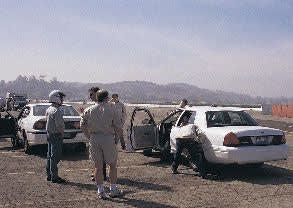After the prelim, which is a good simulation of pursuit conditions, the brakes were tested. The drivers accelerated the vehicles to a speed of 90 mph, then applied the brakes. The goal was to maintain a 22-feet-per-second deceleration rate.
The deceleration rate test was repeated twice, and each vehicle was allowed to cool down for five minutes. Then each vehicle was accelerated to 60 mph, and the brakes were applied - just short of the ABS feature becoming active. This was repeated twice, and followed by a 60-mph panic stop (with ABS).
If any correctable failures were noted during the braking and deceleration tests, the vehicle was repaired and retested. If the failures appeared to be an engineering defect, the vehicle was disqualified.
The LASD does not record top speeds. However, the elapsed time and speed to complete each lap was measured, as well as the acceleration time to various speeds, including 0 to 100 mph.
Pursuit class vehicles receive a second evaluation on a "Pursuit Course." This course covers 2.45 miles, simulating a pursuit in an urban area. There are no straight-aways, and various obstacles are intermixed with various right and left turns. The Pursuit Course is also utilized in the tire tests, which include tires from several manufacturers.












